|
Archive of Past Artist - for reference only At the close of the 2017 Season, Both North Rim and South Rim AiR Programs will be been suspended indefinitely. You may check this webpage periodically for updated information. If you have further questions, you may email us at GRCA_AiR@nps.gov 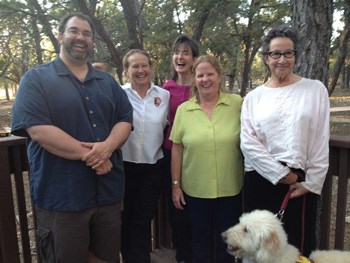
Our brilliant and happy 2013 South Rim Jury Panel! Meet the Jury Panel! J.T. Tannous- Executive Director: Coconino Center for the Arts, Flagstaff, Arizona Judy Hellmich-Bryan - Chief of Interpretation, Grand Canyon National Park, Arizona Kim Buchheit - graphic designer; mixed-media studio artist; curator; Grand Canyon National Park, Arizona Susan Verkamp - writer; Taos, New Mexico April Werner - painter; Taos, New Mexico
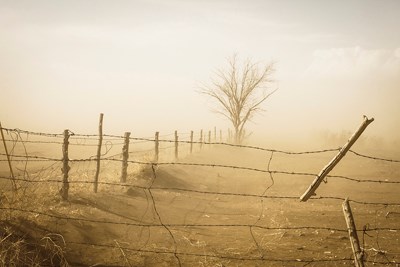
Fence and Elm Tree in a Dust Storm; Archival pigment print; 2013 October, 2013; media arts/photographer Kathleen Brennan; Rancho de Taos, New Mexico. Kathleen has been studying photography since her childhood in New Jersey. In 1973 she moved to Albuquerque, where she earned a degree in photography from University of New Mexico. Kathleen has been living in Taos, New Mexico since 1992, and is an award-winning, frequently exhibited artist. Kathleen's diverse body of work explores the idea of the transformative process of our world, both culturally and environmentally. She's interested in capturing the beauty of the subtle – in both her landscapes and portraits. She has photographed the high plains deserts decimated by the dust storms of the 1930s, the surgical scars on a woman undergoing breast cancer treatment, and the changing appearance of a man dying of AIDS. Her work tenderly exposes the vulnerability and strength of these diverse subjects in order to evoke a protective response from her viewers – with empathy comes action and advocacy. While in-residence, Kathleen intends to document the four elements – earth, water, fire and air – as they sculpt the environment of the Grand Canyon ecosystems. She'll be working with soundscapes, video and time-lapse photography to create final work that expresses the transitory nature of the desert southwest, as well as the slow processes that literally and figuratively shape how people view this rarest of landscapes. Kathleen: "The earth cannot exist without the natural elements and their delicate, fluctuating balances. However, as our world becomes increasingly urbanized, fewer people have first-hand experience of the complex, interacting natural forces that sustain life on our planet. I am drawn to portraying places, people and things we are apt to ignore as empty, old, or broken, in order to re-open our eyes to their beauty - and the impact on the earth of natual and manmade forces. My images are emotionally evocative – cultivating a sense of the preciousness of life. While at the Grand Canyon I intend to apply this focus to my work with the ultimate aim to evoke the experience of living amidst the elements in the Grand Canyon, with a goal of inspiring people to notice, appreciate and preserve." 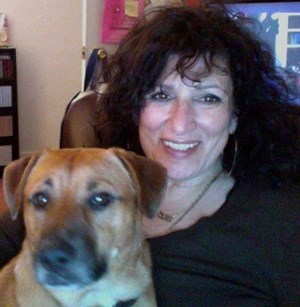
Writer Elmaz Abinader with Brewster November 1 - 24, 2013; writer Elmaz Abinader; Oakland, California. Elmaz is an Arab-American, the child of parents dislocated from Lebanon to the US. Her work is inspired by the complexities of race, religion, and geography and how those are rooted in personal experience. She addresses such issues as occupations and disenfranchisement experienced by people dislocated from global places of conflict. Elmaz teaches non-fiction, memoir and poetry at Mills College in Oakland, and is an award winning author, including a PEN Award for In the Country of My Dreams, and a Goldies Award for Literature. She was a Fulbright Scholar to Egypt, has conducted writing workshops in Palestine and has toured several countries with her plays (accompanied by the Country of Origin Band). She is the co-founder of the Voices of our Nations Arts Foundation, now in it's 15th year. Elmaz's current project is a novel When Silence is Frightening (working title), which she will be working on while in-residence. This residency experience offers the dramatic change of place - an interesting shift for an artist in mid-project. Elmaz: "I'm seeking a kind of dislocation myself – from my jam-packed and demanding life in a city to the inspiring visages of the Grand Canyon. My recent book of poetry parallels the shifts in the earth's surface to the changes in body, physical memory and sensory activity. My current novel investigates how shifting environments, especially radical changes, challenges the self. Nothing is static about the Grand Canyon – light and life shift constantly, the flux is brillant and disturbing -- like all changes. We as a people change the world by shifting ourselves – not though the large political acts but how we place ourselves, create our villages and use or misuse our lands. Although my stories take place in many countries, the sense of discontinuity is universal. I will explore these ideas while in-residence." 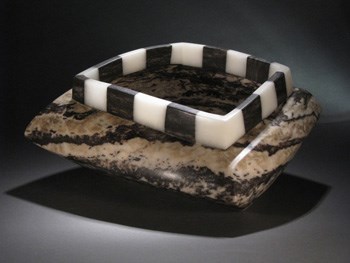
Stone carver Susan Zalkind from Camp Verde, Arizona will have a mini-residency from December 9th – 13th, 2013.
Susan and her husband Paul Hawkins were awarded a residency in 2012, and scheduled to be at the south rim in September of 2013. A few short months later, Paul was diagnosed with cancer. After months of alternating illness and robust health, Paul succumbed to his illness, surrounded by loved ones, on September 17th. The Grand Canyon community and Artist-in-Residence program extends our deepest sympathy to Susan and their family for this loss. Susan will come for a full 3-week residency at some point in the not-too-distant future. During this short-term December opportunity, she will be in-retreat and working on personal projects; upon her return she'll present public programming. Susan and Paul have been artistically adventurous collaborators for over 37 years. Quarrying their own translucent American Alabaster from sites in the southwest, they carved their stone vessels and sculptural pieces, creating elegant and evocative stone work. American Alabaster offers a full palette of colors; deep reds, light pinks, yellows, greens, purples, and black and white, which they sculpted into astoundingly exquisite forms. Their work process always starts in the hand gathering of the materials; an arduous task of digging and hauling each uncut rock over rubble piles and down steep canyons. They find this physically satisfying labor, allowing them to connect intimately with each piece of stone, creating a dialogue with the materials that helps define the direction of the final work. Using both hand tools and small grinders, yielding the thinnest possible stone pieces, their work has the illusion of movement, life and delicacy in spite of the weight and strength of the stone itself. Each original work reflects the subtly rich landscape of the deserts. Susan continues the legacy of the collaborative work she and Paul shared, creating these lovely and resonate stone pieces. Please check back for information on dates and program information regarding Susan's return, three-week residency. 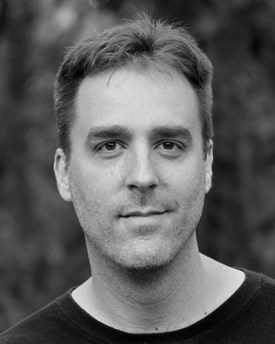
Composer James Romig December 15 - 21, 2013; composer James Romig and pianist Ashlee Mack;Macomb, Illinois. James was in-residence May, 2012, accompanied by his wife, pianist Ashlee. They return to the south rim in December to present a special concert of new compositions (plus some older original work) inspired by their Grand Canyon residency experience. This special concert will be on Thursday, December 19th, 7:00 p.m. at Shrine of the Ages, and is free and all-ages friendly. James Romig composes music that endeavors to reflect the intricate complexity of nature, where fundamental structures exert influence on both small-scale iteration and large-scale design, obscuring the boundaries between form and content. His work shows the influence of academic study with Charles Wuorinen and Milton Babbitt, interaction with the natural world through hiking and photography, and an interest in chaos theory, fractal geometry, and small-world networks. Recent guest-composer visits include Northwestern University, the Aspen Institute, University at Buffalo, the Cincinnati Conservatory, the University of Illinois, Juilliard, and the American Academy in Rome. Residencies include Petrified Forest National Park, Grand Canyon National Park, and Copland House. He holds degrees from Rutgers University (PhD) and the University of Iowa (MM, BM), and has been on faculty at Western Illinois University since 2002.
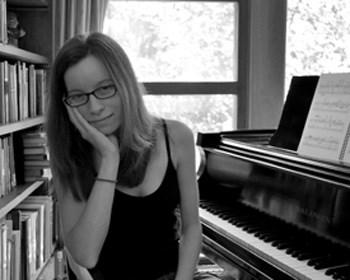
pianist Ashlee Mack - sitting at Aaron Copland's piano Pianist Ashlee Mack has given recitals in Germany, Italy, and across the United States. As a specialist of contemporary music, she has performed solo and chamber music with organizations such as the Society for Chromatic Art, Vox Novus, New Music Forum, Iowa Composers Forum, New Music Festival at Western Illinois University, Aspen Composers Conference at the Aspen Institute, PASIC, and SCI. She is a co-founder of the Khasma Piano Duo, dedicated to the performance of music from the 20th and 21st centuries. Mack's recordings of Odds and Ends by Robert Morris and For Milton by Christian Carey are featured on a Milton Babbitt memorial CD published by Perspectives of New Music/Open Space. Her recording of James Romig's Transparencies was recently released on Navona Records. Primary teachers include Lois Svard (Bucknell University), Michael Adcock (Washington, DC), and Alan Huckleberry (University of Iowa). She is currently the Coordinator of Piano Instruction at Knox College in Galesburg, Illinois. 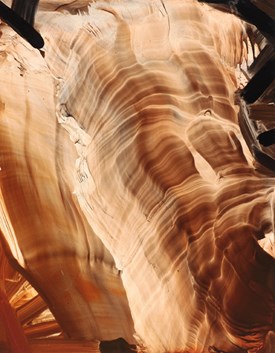
Ashes 10; (one of 25 panels that complete the painting Ashes); Oil on clay board; 11" x 14"; 2012 December 22, 2013 - January 11, 2014; painter Monika Bittman; Santa Fe, New Mexico. Born in Prague Czech Republic, Monika graduated from Hollar School of Art in Prague, and received her MFA in painting from the University of New Mexico Monika’s work explores pattern in nature. She has constructed string sculptures that gave shape to bifurcation and mathematical formulas, drawn into wet gesso in order to understand patterns occurring on the surface of water and watched patterns emerge from repeated brush strokes. Influenced by Japanese sumi-e painting and Chinese splash-ink painting, Monika’s current work involves manipulating thin oil paint on panels through tilting, dripping, smearing and blowing, allowing the viscosity of the paint, gravity and time to determine the work’s final result. The resulting images resemble forms found in nature and, although she doesn't paint from nature, her paintings frequently evoke nature. Monika: "The Grand Canyon is a wonderful place to study natural patterns. For instance, the fractal design made by a path of trickling water can be observed in both a stream of raindrops eroding the ground at my feet as well as the grand shape of the canyon itself." Monika's art is also about being present. "My painting process teaches me to be aware of what is unfolding moment by moment. It teaches me to closely observe my materials and allow them to reveal nature's inherent propensity to organize itself. This approach of witnessing and allowing rather than imposing, teaches me a way of being that is applicable to all kinds of situations, not just painting." Nowadays our lives are so often driven by expectations that we can lose our ability to be open to what is actually happening. Visiting such an impressive site as the Grand Canyon, our expectations can prevent us from taking in our experience. On a recent winter visit to the canyon, I was surprised by an unexpected visual phenomenon. Just after sunset, I looked across the canyon from the south rim and suddenly saw emerald green in the atmosphere when I had expected only orange canyon walls and the purple-blue shadows of dusk. I look forward to opening to moments like this during my time in the canyon environment.” 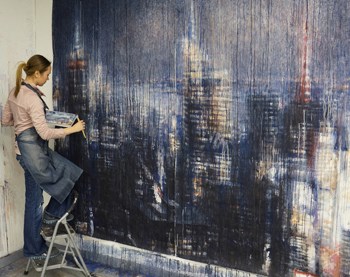
Ekaterina Smirnovia working on Rainy Manhattan; watercolor painting; 90" x 104"; 2012 January 12 - 31, 2014; painter Ekaterina Smirnova; New York, New York. Born and raised in Russia, Novosibirsk, Ekaterina has studied art, but graduated with a law degree. When Ekaterina arrived to the US, she continued her art education at the Art Students League of New York. Ekaterina is a widely exhibited and award-winning artist. This will be her first visit to the Grand Canyon. Ekaterina is an atmospheric landscape painter. She's interested in the interplay between contrasting light against darkness – and how soft-focus on hard edged structures can result in both recognizable and abstracted locations. Ekaterina often paints her adopted hometown of New York, typically from elevated points of view, such as the observation decks of the Empire State Building, or Rockefeller Center. Most recently Ekaterina has been traveling, painting in cities throughout Asia, Europe and the United States. Working with water-based paints, Ekaterina brushes, splashes, drips and puddles water and paint to create her atmospheric urban landscapes, aiming to capture transitional light and weather, engaging her energetic and physical painting technique. Glazing and repeatedly splashing the painting, Ekaterina creates very large-scale paintings using basic tools such as hardware brushes, rough textured paper, and sprayed, splashed or brushed-on water. Ekaterina: "I am an atmospheric painter, and in my work I capture different shapes of water. Snow as another form of water is a part of the large natural system that is so radically changing the shape of the planet. Snow on the rocks of the Grand Canyon is maybe looking very innocent, but its power is not to be ignored. I intend to paint the different sides of snow, its beauty and danger, and hope to catch different weather from sunny days with reflective snow to severe snow blizzards during my winter residency". 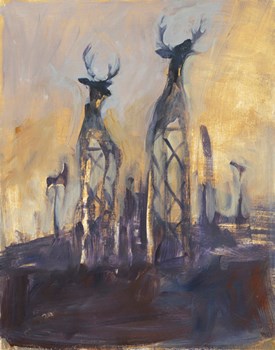
Shadows That Build; acrylic on panel; 14" x 11"; 2010. February 1 - 22, 2014; painters Kathryn W. Schmidt and Jay Schmidt; Bozeman, Montana. Kathryn's moody and narrative acrylic paintings evoke a mysteriously elusive mythology. Her spooky tableaus often feature famous artifacts from human history coupled with unsettling images of people and deer in parched and devastated landscapes. Her work discusses the tragic results of interaction between humans, animals and the earth, and reflects her concerns about environmental devastation, specifically related to climate change. Kathryn's paintings visually describe man's careless exploitation of the earth, and our inability to seek peace between each other and our shared planet. Kathryn also creates tiny and intimate bronze sculptures of human beings that evoke wandering and seeking, which she sometimes installs directly on top of her paintings. Kathryn grew-up in Iowa, where she received a BFA from University of Iowa, and after working in New York City and London, settled in Bozeman, Montana. She is a much-exhibited and collected artist, and is a recent recipient of the Montana Arts Council Innovation Award (2012). She has been in-residence at the Djerassi Foundation (La Honda, CA; 2007 & 2011), Ucross Foundation (Ucross, WY; 1998 & 2004) and the Hungarian Multicultural Center (Budapest, Hungary; 2006). Kathryn: "I have always been a proponent of art that carries content. But how to balance ideas and aesthetics is the question. The idea of this residency and my daily work is to find ways to address the things on my mind and speak in a timeless way. The issues that bombard us, after all, are the perennial ones, like dealing with power and resources. Shakespeare still speaks to us because we haven't changed, or change only slowly. Maybe E.O.Wilson says it best: 'We have a Star Wars civilization, with Stone Age emotions, medieval institutions, and godlike technology.' While in-residence I intend to continue working with figures in the landscape, with the Grand Canyon as a backdrop" 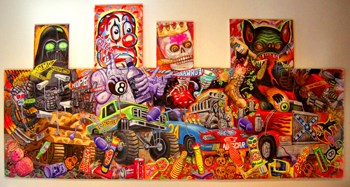
The Four Horsemen; oil on canvas; 116" x 214"; 2013 A widely exhibited and collected artist, Jay received his BFA from Kansas City Art Institute, and an MFA from the University of California, Davis; he recently retired as head of Montana State University's sculpture department. Jay's large-scale, mixed-media paintings are visually raucous and appear aggressively cheerful, but upon closer inspection it's clear that his work is highly narrative and serious, addressing specific contemporary issues that concern him. His paintings comment on a wide variety of political, social and cultural issues ranging from criticism of unjust global financial structures to environmental catastrophe, with an emphasis on the blindly frantic consumerism that dominates our social structure. Jay creates solo studio work, but is also vitally interested in collaboration; he is a member of the collaborative groups Paintallica and The Living Breathing Thing. Paintallica is a group of like-minded artists who gather periodically to brainstorm, and then pull together relatively spontaneous site-specific, mixed-media art installations, using found and fabricated objects and such unconventional tools as chainsaws and fire to create their short-lived pieces. The Living Breathing Thing is a smaller collaborative installation group project which includes drawing, performance, spectator participation, film and music, with the goal of facilitating art making in a free and intuitive environment. Jay's solo and collaborative work largely focuses on creating community and responding to cultural and social issues in real time. Jay: "A carnival sensibility is a strong element in my work today. I view the world as being in a political, financial, social and environmental state of dysfunction. We seem unable to address the significant problems that face us. As a narrative artist I feel blessed to have the opportunity to address these issues and in some simple way to define my place in the world. The process of forming these concepts is a mysterious mixture involving intuition, a little anger and mischief, and of course, a little humor to smooth things out. The goal is to make a good painting or sculpture rather than a specific didactic statement. During my Grand Canyon residency I will focus on the issues affecting the environment and climate change, working directly from the landscape in plein air sessions." 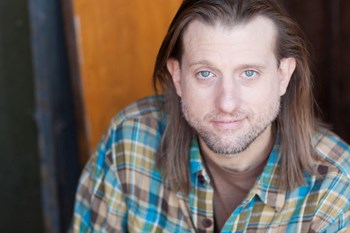
Chicago, Illinois playwright and performing artist Scott Bradley will be in-residence February 23rd – March 15th, 2014. Scott Bradley is the Creative Producer and co-founder of The Scotty & JoJo Show, a critically-acclaimed Chicago, Illinois based creative collaboration with Jonny Stax. The Scotty & JoJo Show develops theatrical entertainment to fuel social evolution, exploring American cultural iconography through a contemporary gender-queer lens, incorporating elements of comedy, puppetry, drag, spectacle, film, music, vaudeville, and dance. In addition to his work with the Scotty and JoJo Show, Scott has collaborated in the development of new plays and musicals, and devised theatrical works for a variety of American ensemble theaters from coast to coast. Scott is a member of the Dramatists Guild, AEA and SAG/AFTRA. Scott: "Our National Parks offer opportunity for conversations amongst diverse populations, and the south rim offers our country's most epic theatrical event in this context, each year bringing millions of people from all over the globe together to share a moment of wonder, where cultural differences melt away for an instant. In that instant of shared experience is the possibility of transcendence. As a gender-queer artist, I am interested in the spiritual cultures of the southwestern Native American populations and the role of the two-spirit, as well as the different cultural understandings of gender spectrums. I would like to learn how the Grand Canyon and its ecosystems inform this understanding, as a home and as a sacred space for the indigenous people of the southwest. At the heart of all my work is a desire to propel social evolution toward greater understanding and compassion" During his residency, Scott intends to explore the idea of temporary community and shared experience via informal contacts and interviews with park visitors and locals. He will also conduct storytelling workshops with local public school students. Within two years of his residency, Scott will return to the south rim to present a site-specific theatrical piece that celebrates the Grand Canyon as a place that invites conversation amongst disparate people. This work will incorporate elements of comedy, puppetry, drag, spectacle, music, vaudeville, and dance, celebrating the uncommon experience of temporary community and shared experience. 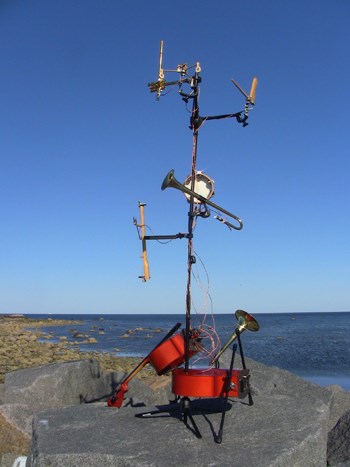
by Brack Morrow
Brack studied engineering (with an emphasis in sound mitigation) and mathematics, and has a BFA in sculpture and MFA in interdisciplinary practice; these disciplines come together in his beautifully constructed sculptural sound machines. An award-winning artist, arts educator and luthier, Brack's sound machines are carried or driven by remote control across a landscape, creating and collecting sounds, which then come together in complex, site-specific soundscapes. This work has taken him from the mouths of caves to the seashore, from remote sites above timberline high in the mountains to desert landscapes, collecting sounds unique to time and place. Brack is bringing two of his sound machine sculptures to his residency – the Remote Station Violin and the EAR1. Remote Station Violin is a portable device constructed from string instruments and recording equipment, which Brack can carry into isolated, off-road wilderness settings. EAR1 - the Earth Aural Rover – is a remote-controlled recording device and musical instrument vehicle inspired by the ongoing mission of NASA's Curiosity. Both devices directly interpret ambient sounds as well as other measurable environmental data including temperature, humidity, wind speed, and vibration. Additionally they can be played like musical instruments. Brack: "Every day we witness more and more of our planet's resources disappearing. It is good that we explore our universe and other planets; it is imperative that we also explore, understand, and appreciate the environment we call home. Creating new ways to contribute to how we perceive our environment will help inspire collaborations and establish creative sustainable solutions to our environmental issues. Using my recording machines combined with research into the areas of neuroscience, music, visual art and linguistics, I seek to explore and experiment using the languages of art and science. The geological record within the canyon ecosystem provides one of the greatest histories of our earth. My explorations will result in a unique, Grand Canyon soundscape profile, contributing to my on-going National Parks project." During the three week residency Brack will explore the rim and inner Canyon trails with both the EAR1 and his portable recording devices. Working with local scientists, artists and the general public, Brack will combine scientific data and musical improvisation to create original canyon inspired compositions, which will be audibly recorded as well as documented with photography and film. When Brack is not in the field with his recording devices, his machines will be on display at Park Headquarters, open daily from 8:00 a.m. – 5:00 p.m. 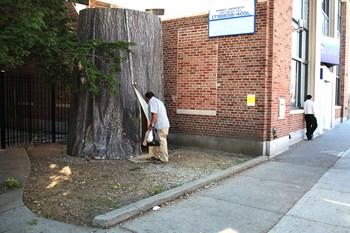
photo credit: Joanna White April 12 - May 3, 2014; mixed media collaborative artists Jenny Polak and Dread Scott; Brooklyn, New York. Dread and Jenny are artists whose work examines contemporary social justice issues. They are a couple who share a studio but generally work solo or with other artists and groups, so this residency offers them the rare opportunity to work on a collaborative project. Jenny's work is grounded in her formal background in architecture, and includes architectural installations, drawings, web-based work and interactive objects. She's invented a fictional architecture firm – Design for the Alien Within – which centers on the idea of creating (hypothetical) safe hiding places for at-risk people, specifically undocumented immigrants. This work reflects on her family history of immigration, and the upheaval, risk and unknown that comes with relocating into a new culture. With materials ranging from cardboard to paint to solar-powered runway approach lights, Jenny's work celebrates people's desire to help each other survive hostile environments and circumvent the systems that further subjugate the least powerful in our population. Working with the dichotomy of visibility and secrecy, Jenny's projects include interactive hiding places and temporary dwellings, as well as protective clothing created from discarded materials created by our financial institutions. Jenny is originally from England; she received a BA in architecture from Cambridge University, and a Fine Art and Critical Studies BA from St. Martins School of Art in London before moving to New York to pursue her MFA in Visual Arts Studies from The School of Visual Arts. She is an award-winning and frequently exhibited and sited international artist. 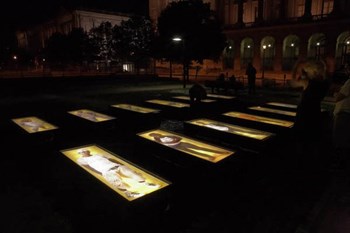
Collaborative piece; Dread Scott with Philadephia youth Dread first received national attention in 1989 when his art became the center of controversy over its use of the American flag. The discussions that came out of that exhibit ultimately resulted in a Supreme Court case and a landmark First Amendment decision. His work focuses on the profound social polarization that has contributed to the exploitation and suffering experienced by billions of every-day humans, perpetrated by unjust social, political and global forces. Seeking to help humanity forge a radically different world without exploitation or oppression, Dread’s work encourages the viewer to envision how the world could be by exposing people to how it is for the disenfranchised. He’s created performance pieces that reflect on the fact that America is a country whose democracy is rooted in slavery, as well as work that examines the huge global systems that have created contemporary economic injustice.
While in-residence, Jenny and Dread will pursue their collaborative video and photography projects and spend time hiking and exploring, including research in the National Park archives and collections. They will present their work to local high school students and offer an Evening Program artist talk towards the end of their residency, in which they’ll present in-progress new work, as well as older finished work. The Evening Program is scheduled for Sunday, April 27th, at Shrine of the Ages, 7:30 p.m. 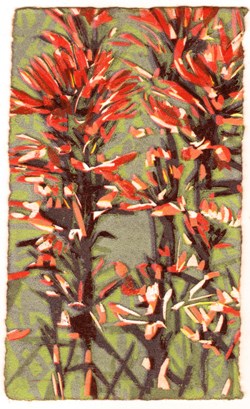
by Jean Gumpper May 5 - 31, 2014; printmaker Jean Gumpper; Colorado Springs, Colorado. A master printmaker who specializes in highly technical reduction prints and pochoir (a sophisticated stencil process), Jean's work largely focuses on plants and the richly complicated landscapes in which they are found. Her prints are astonishingly technically proficient, but more than that they are moments of a particular day, time of year and place – a visual capture of one deeply experienced moment. Her process starts by immersing herself in a landscape, and then sketching, shooting reference photos and creating small gouache (opaque watercolor) painting studies, before returning to her studio to begin carving into the wood blocks from which she'll pull her prints.
Jean is a widely collected and exhibited award-winning artist, with prints in private and public collections in the United States, Canada, Finland, Germany, Japan, Nepal and Sweden. She received an individual Visual Artist Fellowship award from the Colorado Council on the Arts in 2000, and has had numerous residency opportunities including Ucross Foundation (Wyoming; 2001), and Rocky Mountain National Park (Colorado; 1998). Jean is a Visiting Professor and Mellon Artist-in-Residence at Colorado College in Colorado Springs, and has taught international print workshops at the University of Gothenburg, Sweden, and is a frequent guest artist instructor at Anderson Ranch Art Center in Snowmass, Colorado.
Jean: "Being alone in nature helps me to listen to my intuition and to have the patience necessary to really see. I seek to integrate the memories, sounds and feelings of being in a landscape into the making of a print, integrating the process with form and content. It is a way for me to relive an experience and to share it with others, using landscape as a metaphor for emotions and experiences.
My work often focuses on the theme of water. Being in the Canyon for three weeks will give me time to begin to understand the ideas of water as the "life blood" of this desert landscape. I want to see the places in the Grand Canyon where water gushes out of rock - and how different colors of water mix together when streams meet at the Colorado River. I will search for intimate environments of seeps and springs and riparian habitat by hiking the inner Canyon all the way to the river. These experiences will then become the narrative of the work that comes from this residency. To me, images created in this way become rich in meaning - suggesting resilience, renewal, beauty and new life in a time of constant change." While in-residence, Jean will teach a hands-on workshop to local park staff. An exhibit of her work will be shown in Park Headquarters from May 6th – 30th, open daily from 8:00 a.m. – 5:00 p.m. 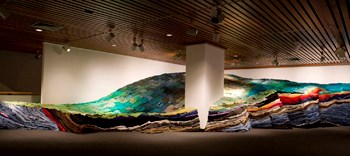
by Jarod Charzewski June 1 - 21, 2014; found object & recycled material installation artist Jared Charzewski; Charleston, South Carolina. Originally from Winnipeg, Manitoba, Jarod received his BFA in sculpture from the University of Winnipeg, and his MFA in sculpture from the University of Minnesota in Minneapolis. He has been an Assistant Professor in the sculpture department at the College of Charleston, South Carolina since 2006. He is an award-winning and frequently exhibited installation artist whose work has been shown nationally and internationally. Jarod is an artist who creates large-scale, site-specific pieces that reference western civilization’s consumer culture by using its discarded yet usable items as the main materials. Jarod designs massive and fantastic landscapes, creating a witty and insightful commentary that encourages the viewer to consider their own role in our cycle of use and discard. He’s worked with discarded books to create free-standing sculptures, items from a renovated commercial kitchen which resulted in a visually lyrical mixed-media mural, and carefully folded and assembled piles of second-hand clothing, stacked into elegant organic shapes. His work is all about human impact on our planet, and seeks solutions to large contemporary issues, particularly our unhealthy purchase/discard cycles that create environmental and public policy concerns. His work seeks to gently remind us through sheer volume of materials, the impact we have individually and collectively on the earth. Since being selected as a south rim Artist-in-Residence, Jarod has been working on designing a site-specific piece that will be installed in Park Headquarters courtyard during his residency. This work references geology, anthropology and sociology, while being visually compelling and inviting. This piece will use an enormous amount of recycled garments, which he has carefully curated for color and texture, and sent out in two enormous crates to the south rim. Within days of his arrival, Jarod will begin building a wooden armature which will eventually support the weight of nearly 1200 pounds of neatly folded and stacked fabric, which will create the appearance of sedimentary rocks and reflect the geology of the Grand Canyon itself. Jarod will work solo for the first week of his residency, and on the week of June 9th will have open-studio hours in Park Headquarters courtyard, welcoming park visitors and staff to come and see the work in-progress and lend a hand. Open studio/public participation hours will be daily, June 9th - 13th from 1:00 - 3:00. All sessions will be all-ages and family friendly. If you miss these open studio hours, please stop by to see the work in-progress and perhaps catch Jarod for a conversation. The piece is expected to be complete on or around June 17th. The final installation will be on display on-site through the summer, dependent upon the speed of degradation of the materials and the onset of the monsoon season. 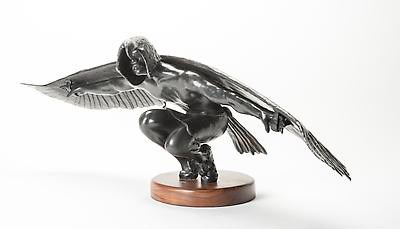
by Michael Naranjo June 22 - July 12, 2014; bronze sculptor Michael Naranjo; Albuquerque, New Mexico. Michael Naranjo is a member of the Native American Tewa tribe of the Santa Clara Pueblo, New Mexico. Michael's mother was a potter of the famed Santa Clara Pottery tradition, and Michael often helped her prepare her clay, spending countless hours with her in studio. Always a creative child, Michael knew from a young age that he would be a sculptor as an adult. His childhood dream was gravely challenged when, while serving in the US Army in Vietnam in 1968, he was badly injured by a grenade explosion that permanently damaged his right hand and left him blind in both eyes. Ever resilient, he learned that he could depend upon his sense of touch and his memory - to recall childhood experiences of hiking, fishing and hunting with his brother in Northern New Mexico and working with his mother in her clay studio. This vivid recall of his childhood informs his work to this day. Michael's cast bronze sculptures begin with modeling clay, from which he builds the figurative and representational models. Working in all sizes from miniatures to monumental, his sculptures include lively and gestural images of Native American ceremonial dancers, beautiful and peaceful female figure studies of woman engaged in everyday domestic or contemplative activities, and powerful pieces that speak of his service in Vietnam. His work is always meant to be touched, and the finely wrought, decidedly unfussy, smooth polished surfaces invite that universal human impulse. Michael's award-winning art is widely collected and exhibited, and he is a passionate advocate for the establishment of hands-on museum experiences. He's had some remarkable experiences in this area himself; the Italian government allowed him to mount a specially-built scaffold and to come into actual physical contact with Michelangelo's David in Florence. His advocacy work on behalf of disabled artists and audiences includes projects with U.S. cities and museums including the Heard Museum in Phoenix, Arizona, and the Eiteljorg Museum of American Indian and Western Art in Indianapolis, Indiana. In 1983 Michael was received by Pope John Paul II, who accepted a gift of Michael's piece Going Home. His piece Dance of the Eagle is in the permanent collection of the White House. In 1990 he was honored with the Distinguished Achievement Award from the National Press Club in Washington, D.C. and in 1999 he was the LIFE Foundation's Presidential Unsung Hero. Michael: "Suddenly finding myself blind, and with minimal use of my right hand, I had to learn to depend on recall of images I remembered from when I could see. At times, there was a lot of trial and error involved in my creative process, but I was determined to find a way to work through my disability. Over the years, my blindness has made me realize that, for me, the feeling of the piece becomes more important than intricate detail. My work is representational, and the patina I choose for my bronzes is matte black, which has become my trademark, as this is the color I see. I have always been inspired by the natural world around me. Immersing myself in this residency will be inspiring, and will allow me to connect with the Grand Canyon in a very personal way. Many of my sculptures reflect my culture, things I remember growing up on the Pueblo - and like the Grand Canyon itself, I like to think my work might also persevere over time and continue to communicate with people across cultures, abilities and generations. This opportunity at the Grand Canyon will give me the time and insight to reconnect with nature and see how it affects my work. It will, quite literally, be a breath of fresh air." While in-residence Michael will be working with summer youth groups. Park Headquarters is hosting a small exhibit of Michael's cast bronze work, open daily from 8:00 a.m to 5:00 p.m. Please Touch The Art! 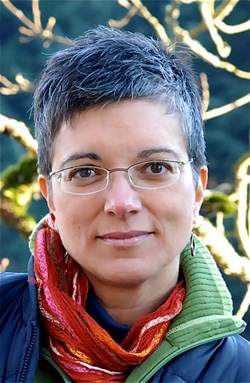
July 14 - 21, 2014; returning writer-in-residence Naseem Rakha from Siverton, Oregon. Naseem was the south rim Artist-in-Residence, February 2013. She is an award-winning journalist whose stories have been heard on NPR's All Things Considered, Morning Edition, Marketplace Radio, Christian Science Monitor, and Living on Earth. Also an award-winning novelist (The Crying Tree), Naseem recently gave an eloquent and moving TED talk that spoke of personal insights that came from her Grand Canyon experiences. From July 14th – 21st, Naseem returns for a week-long guest artist visit. She will present a reading of her work in an Evening Program on Friday, July 18th, 8:30 p.m. at McKee Amphitheater. In this all-ages presentation, Naseem will read from her Grand Canyon-inspired essays and share stories from her residency experience and her Grand Canyon backcountry hiking adventures. Join us under the stars for this special event! 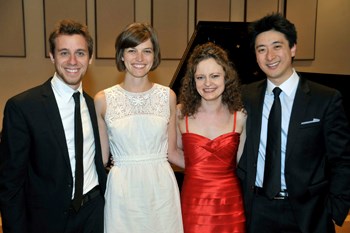
Chamber Music OC August 3 - 30, 2014; Chamber Music OC; pianist Kevin Kwan-Loucks; violinist Iryna Krechkovsky; violist Michelle Gasworth; cellist Ross Gasworth; Irvine/Orange, California. Founded in 2012 by pianist Kevin Kwan Loucks and violinist Iryna Krechkovsky, CMOC is rounded out with the talents of violist Michelle Gasworth and cellist Ross Gasworth, to form a vital and lively nonprofit organization dedicated to advancing the art of chamber music through performance, education, and community. The four governing members of Chamber Music OC share a substantial amount of experience as international concert artists, university-level music educators, artists-in-residence for various academic institutions and professional organizations, and participants in special community outreach projects.The governing of CMOC is a collaborative task; Kevin is Artistic Director, Iryna is Director of the Young Artist Programming, Michelle is Director of Community Outreach, and Ross is Director of Media and Marketing. CMOC's central philosophy circles around the mission of bringing communities together through the power of music, and fostering the next generation of classical musicians in southern California. The extraordinary talents of the quartet will be on full display in a special concert on Friday, August 16th, 8:00 p.m. at Shrine of the Ages.This concert will feature compositions by Pierre Jalbert, Gabriel Faure and Johannes Brahms.All Artist-in-Residence programs are free and family friendly.
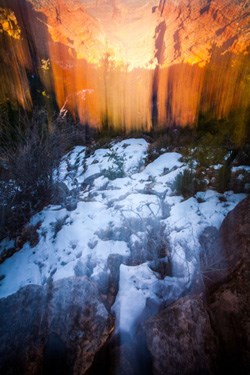
September 1 - 21, 2014; photographer Ty Bowman; Lakewood, California. Ty Bowman's art suggests a passionate connection with Nature, with the goal of inspiring a world view that leads to greater stewardship of life on Earth. His work varies from tire-tread sculpture to experimental photography;his newest work includes programmatically processed imaging from video streams. Ty works in the field using his own in-camera blur technique capturing images that at times become dreamscapes or abstractions intense with color. Ty's subjects range from the architecture of ancient cultures, to the geology, water and flora of the canyon. Stemming from his early experiences of the out of doors and a lifelong bond with the natural world, this work speaks about a connection with the subject be it the transcendent beauty of Nature, memories of past cultures or the timelessness of life on earth. Ty earned his BA in journalism (photojournalism) and BFA (studio art) at University of Texas at Austin, and his MFA (printmaking) at North Texas State University in Denton, TX, with further studies in graphic design at UCLA.Ty has exhibited throughout the southwestern states including Gallery of Functional Art, Santa Monica. CA;College of Santa Fe Sculpture Project, New Mexico;Photo Art Gallery, Burbank, CA;and the TAG Gallery, Santa Monica, CA. He is a past recipient of the prestigious Helene Wurlitzer Foundation Fellowship, Taos, New Mexico. Ty: "Once while hiking in a remote, pristine wilderness in New Mexico, I looked up and saw jet contrails overhead in the sky –leaving me to think that there is no pristine wilderness remaining on Earth. The machines of our culture, our global village, are everywhere. The wilderness that remains needs to e preserved.Humans have uniquely adapted to the environment we have manipulated, are biologically connected to all other species we share the earth with. I am interested in making art that leads to a deeper connection with our planet and the life it sustains.I plan to explore the Canyon from rim to river, in search of images that exemplify this idea and are specific to Grand Canyon's landscape and cultural history. We have much to learn from native peoples, life sustaining practices we have forgotten along the way in our high tech urban experiences. I've photographed other natural wonders in countries around the world including Egypt, Jordan, Turkey, Greece, China, Italy, France, Romania, Russia and England. I will continue to pursue these and other themes in the work I will do during my stay." While in-residence, Ty will present an Evening Program artist talk discussing the themes of his work and featuring his past photography.This program is scheduled for September 17th, 8:00 p.m. at Shrine of the Ages.Additionally, Park Headquarters is hosting an exhibit of Ty's work through September 20th.Park Headquarters is open daily from 8:00 a.m. to 5:00 p.m.
Please check back for updated artist bios! Former Selected Artist in Residence (for reference): Selected Artists - South Rim - October 2014 - October 2015Selected Artists - South Rim - October 2013 - October 2014 Selected Artists - North Rim - 2013 Selected Artists - South Rim - 2012-2013 Selected Artists - South Rim - 2011 - 2012 Selected Artists - North Rim - 2011 Selected Artists - South Rim - 2010 - 2011 Selected Artists - North Rim 2010 Selected Artists - South Rim - 2009 - 2010 |
Last updated: September 28, 2016
